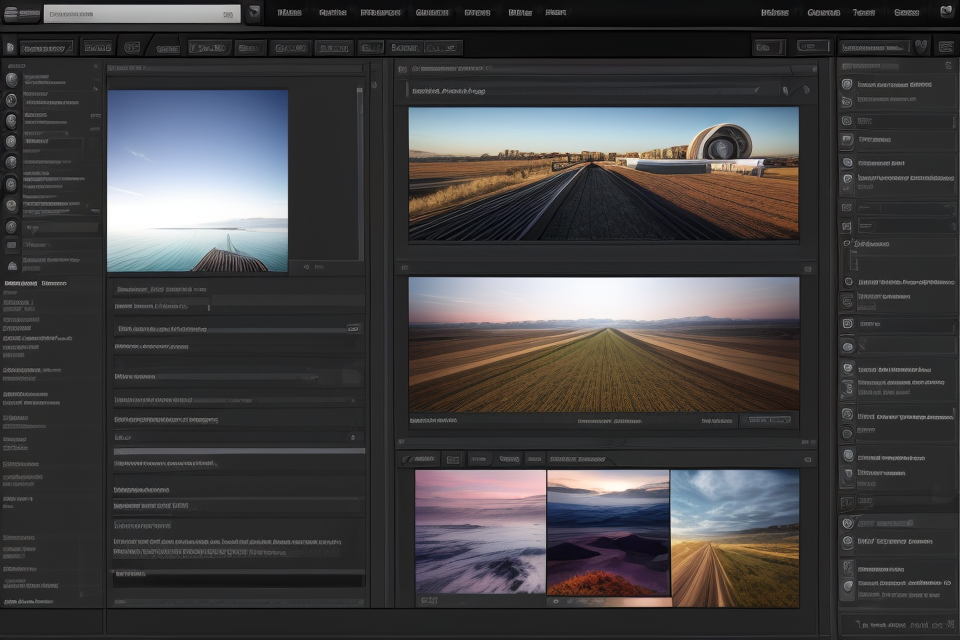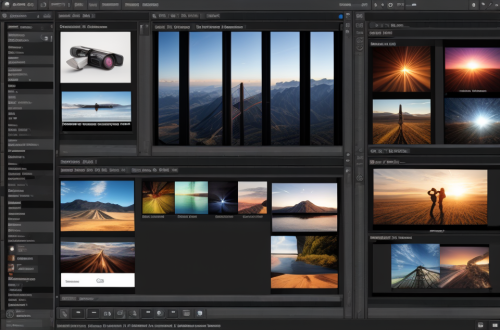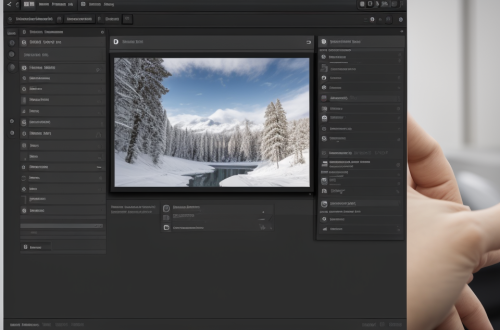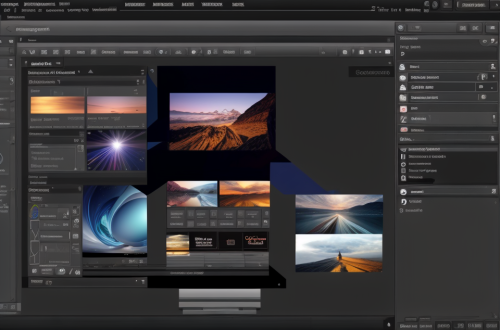The world of photography is a constantly evolving one, with new software and tools emerging all the time. Two of the most popular photo editing programs out there are Adobe Lightroom and Photoshop. But which one is the best for your needs? In this article, we’ll dive into the details of both programs, comparing their features, strengths, and weaknesses, to help you make an informed decision. So whether you’re a seasoned pro or just starting out, read on to discover if Lightroom is truly the ultimate photography software, or if Photoshop still reigns supreme.
What is Lightroom?
Key Features of Lightroom
- Organizing and editing photos: Lightroom is a comprehensive software designed for photographers to organize and edit their photos efficiently. It offers a robust set of tools to help photographers manage their image libraries, including importing, organizing, and tagging photos. Additionally, it provides a wide range of editing tools that enable photographers to adjust exposure, color, contrast, and other aspects of their images.
- Basic photo editing tools: Lightroom includes a variety of basic photo editing tools, such as cropping, straightening, and resizing. It also offers advanced features like the graduated and radial filters, which allow photographers to make precise adjustments to specific areas of their images. Furthermore, Lightroom’s spot removal tool makes it easy to remove distractions like blemishes, dust spots, and other unwanted elements from photos.
- Non-destructive editing: One of the most significant advantages of Lightroom is its non-destructive editing process. This means that all edits made to an image are stored as metadata, allowing photographers to make changes without affecting the original file. This feature ensures that photographers can always revert to the original state of their images if needed.
- Presets and plugins: Lightroom offers a vast collection of presets and plugins that enable photographers to enhance their images quickly and easily. Presets are pre-configured settings that can be applied to images with a single click, saving photographers time and effort. Additionally, Lightroom’s plugin architecture allows photographers to extend the software’s functionality by adding third-party plugins that offer even more editing options.
What is Photoshop?
Key Features of Photoshop
Advanced photo editing tools
Photoshop is renowned for its extensive range of advanced photo editing tools that enable users to manipulate and enhance images with precision and ease. Some of these tools include:
- Adjustment layers: Photoshop’s adjustment layers allow users to apply a variety of non-destructive adjustments to their images, such as brightness, contrast, hue, saturation, and more. This provides users with a high degree of control over their images and allows for easy experimentation and fine-tuning.
- Selection tools: Photoshop offers a comprehensive set of selection tools, including the famous marquee, lasso, and magic wand tools, which enable users to select and isolate specific areas of their images for further editing. These tools are essential for tasks such as retouching, masking, and compositing.
- Brush tools: Photoshop’s brush tools provide users with a range of options for painting and manipulating their images. The brush tools include options for painting with various brush sizes, hardness, and opacity, as well as options for painting with textures and patterns.
- Clone stamp and healing brush: The clone stamp and healing brush tools enable users to remove unwanted elements from their images and replace them with desired content. These tools are particularly useful for retouching and restoration work.
Layering and masking
One of the key features of Photoshop is its layering and masking capabilities. This allows users to work with multiple layers of content in their images, enabling them to experiment with different effects and compositions without permanently altering their original image.
- Layer modes: Photoshop offers a range of layer modes, including normal, multiply, add, and subtract, which enable users to blend and manipulate their layers in different ways. This provides users with a high degree of control over the final result and allows for creative experimentation.
- Layer blending: Photoshop’s layer blending options enable users to combine different layers in creative ways, such as through the use of masks, gradients, and adjustment layers. This allows users to create complex and dynamic compositions.
- Masking: Photoshop’s masking tools, such as the layer mask and the clipping mask, enable users to apply effects and adjustments to specific areas of their images without affecting the rest of the image. This is particularly useful for retouching and compositing work.
Retouching and restoration
Photoshop’s retouching and restoration tools are essential for professional photographers and graphic designers. These tools enable users to remove blemishes, enhance details, and restore old or damaged images.
- Spot healing brush: The spot healing brush tool enables users to remove unwanted elements from their images, such as blemishes, dust, and scratches. This tool is particularly useful for portrait and product photography.
- Cloning tools: Photoshop’s cloning tools, such as the clone stamp and the spot healing brush, enable users to remove unwanted elements from their images and replace them with desired content. This is particularly useful for retouching and restoration work.
- Noise reduction: Photoshop’s noise reduction tools enable users to remove unwanted noise from their images, such as grain and color noise. This is particularly useful for images taken at high ISO settings or with low light.
Graphic design capabilities
In addition to its advanced photo editing tools, Photoshop also offers a range of graphic design capabilities, making it a versatile tool for designers and artists.
- Typography: Photoshop offers a range of typography tools, including text on a path, which enables users to create custom text shapes and paths. This is particularly useful for creating custom logos and graphics.
- Color management: Photoshop’s color management tools enable users to adjust and match colors in their images, making it a valuable tool for graphic design and printing.
- Web design: Photoshop’s web design capabilities, such as the ability to create and export HTML and CSS code, make it a valuable tool for web designers.
Overall, Photoshop’s key features
Comparing Lightroom and Photoshop
Photo Editing Capabilities
Comparison of Editing Tools
Both Lightroom and Photoshop offer a wide range of editing tools to enhance and modify photographs. However, there are some key differences between the two. Lightroom is primarily a non-destructive editing software, meaning that all changes made to an image are stored in the catalog, rather than directly on the image file. This allows for more flexibility and versatility when it comes to making adjustments. On the other hand, Photoshop is a destructive editing software, which means that any changes made to an image are directly applied to the image file itself. This can be beneficial for more advanced users who need greater control over their images.
In terms of specific editing tools, both Lightroom and Photoshop offer a variety of options such as brightness and contrast adjustments, color correction, and exposure adjustments. However, Photoshop offers more advanced tools such as the ability to work with layers, which allows for greater control over the editing process. Additionally, Photoshop has a wider range of brushes and masking tools that can be used to make more precise edits.
Comparison of Layering and Masking
One of the key differences between Lightroom and Photoshop is their approach to layering and masking. Lightroom does not have a layer-based editing system, meaning that all adjustments are made on a single layer. This can make it more difficult to make complex edits and to edit multiple parts of an image simultaneously. In contrast, Photoshop’s layer-based editing system allows for greater control and flexibility when it comes to making adjustments.
Photoshop’s layering system also allows for the use of masks, which can be used to apply adjustments to specific parts of an image. This can be particularly useful for retouching and restoration work, as it allows for more precise edits. Lightroom does have some masking tools, but they are not as advanced as those found in Photoshop.
Comparison of Retouching and Restoration
Retouching and restoration are two areas where Photoshop really shines. Its layer-based editing system and advanced masking tools make it easy to remove unwanted elements from an image, such as blemishes or wrinkles. Additionally, Photoshop’s wide range of brushes and selection tools make it easy to create precise selections for more advanced retouching work.
Lightroom does have some retouching and restoration tools, but they are not as advanced as those found in Photoshop. While Lightroom can be used for basic retouching work, such as removing blemishes or adjusting the brightness and contrast of an image, more advanced work will likely require the use of Photoshop.
Overall, while both Lightroom and Photoshop offer a wide range of photo editing capabilities, there are some key differences between the two. Photoshop’s layer-based editing system and advanced masking tools make it particularly well-suited for retouching and restoration work, while Lightroom’s non-destructive editing system and basic masking tools make it ideal for more general editing tasks.
User Interface
When comparing the user interface of Lightroom and Photoshop, it is important to consider several factors such as the layout, the ease of use, and the learning curve.
- Layout: The layout of the user interface is different in both software. Lightroom has a more straightforward layout with a primary focus on the editing tools, while Photoshop has a more complex layout with multiple panels and options.
- Ease of use: Lightroom is generally considered to be easier to use, especially for beginners, due to its simpler layout and more intuitive interface. Photoshop, on the other hand, can be more complex and requires a steeper learning curve.
- Learning curve: Photoshop has a steeper learning curve than Lightroom. This is because Photoshop has more features and options, which can be overwhelming for beginners. However, once you become proficient in Photoshop, it can be a powerful tool for more advanced editing tasks.
In summary, the user interface of Lightroom is generally considered to be more user-friendly and easier to use, especially for beginners. However, Photoshop has a steeper learning curve but can be a more powerful tool for advanced editing tasks.
Pricing and Availability
When it comes to pricing and availability, both Lightroom and Photoshop have different options and approaches. Lightroom is available as a standalone software, as well as part of the Adobe Creative Cloud subscription. On the other hand, Photoshop is only available as part of the Adobe Creative Cloud subscription.
Here is a breakdown of the pricing options for both software:
Lightroom:
- Standalone license: $149 for a one-time purchase
- Creative Cloud subscription: $9.99/month for a single app plan or $19.99/month for a plan that includes all Adobe Creative Cloud apps
Photoshop:
In terms of availability, both Lightroom and Photoshop are widely available to users around the world. However, some features may vary depending on the user’s location or the country’s regulations.
Regarding system requirements, both software have similar requirements for operating systems and hardware specifications. However, it’s important to note that some features may require higher-end hardware to run smoothly.
In summary, while Lightroom offers a standalone option and a more affordable subscription plan, Photoshop is only available through an Adobe Creative Cloud subscription. Both software are widely available and have similar system requirements.
Ideal Use Cases
Comparison of Ideal Use Cases
When it comes to ideal use cases, both Lightroom and Photoshop have their own strengths and weaknesses.
Lightroom is ideal for photographers who need to edit and manage a large number of photos. Its powerful organization and cataloging features make it easy to sort, rate, and tag photos, and its batch processing capabilities allow photographers to apply the same adjustments to multiple photos at once. Lightroom is also a great choice for photographers who want to quickly and easily enhance their photos with basic adjustments such as exposure, contrast, and color balance.
On the other hand, Photoshop is ideal for photographers who need more advanced editing capabilities. Its powerful tools and layering system allow photographers to manipulate and enhance their photos in ways that are not possible in Lightroom. Photoshop is also ideal for photographers who want to create composites, retouch images, or work with large files.
Comparison of User Preferences
When it comes to user preferences, both Lightroom and Photoshop have their own strengths and weaknesses. Some photographers prefer Lightroom for its streamlined interface and ease of use, while others prefer Photoshop for its advanced tools and flexibility.
Lightroom’s interface is designed to be intuitive and easy to use, with a simple layout and easy-to-understand controls. This makes it a great choice for photographers who are new to editing or who prefer a more straightforward workflow.
Photoshop’s interface, on the other hand, can be more complex and overwhelming for some photographers. However, its advanced tools and layering system make it a great choice for photographers who want more control over their editing process.
Comparison of Professional Needs
When it comes to professional needs, both Lightroom and Photoshop have their own strengths and weaknesses. Lightroom is a great choice for photographers who need to manage and edit a large number of photos quickly and efficiently, as well as for those who need to share their photos online or with clients.
Photoshop, on the other hand, is a great choice for photographers who need to create high-quality images for print or who need to work with large files. Its advanced tools and layering system make it a great choice for photographers who need to manipulate and enhance their photos in ways that are not possible in Lightroom.
Overall, the ideal use case for Lightroom is for photographers who need to manage and edit a large number of photos quickly and efficiently, while the ideal use case for Photoshop is for photographers who need more advanced editing capabilities and flexibility.
Recap of key points
While both Lightroom and Photoshop are widely used photo editing software, they have different strengths and weaknesses. Lightroom is primarily used for organizing, editing, and sharing photos, while Photoshop is used for more advanced image manipulation and graphic design. Here are some key points to consider when comparing the two:
- Organization and Management: Lightroom is designed for managing large collections of photos, with features such as automatic image organization, metadata management, and search capabilities. Photoshop, on the other hand, is focused on editing individual images.
- Editing Features: Lightroom offers a range of basic editing tools, such as exposure, contrast, and color adjustments. Photoshop, however, provides more advanced editing features, including layers, masks, and extensive retouching tools.
- Image Manipulation: Photoshop is known for its powerful image manipulation capabilities, including blending, montaging, and compositing. Lightroom’s capabilities in this area are more limited.
- Graphic Design: Photoshop is also a popular tool for graphic design, with features such as text layers, shapes, and vector drawing tools. Lightroom does not have these capabilities.
- Learning Curve: Lightroom has a relatively shallow learning curve, making it accessible to beginners. Photoshop, on the other hand, has a steeper learning curve due to its extensive feature set.
- Compatibility: Lightroom is designed specifically for photographers and is compatible with a wide range of cameras and image formats. Photoshop, on the other hand, is a more general-purpose image editor and can handle a variety of file types, including graphics and 3D models.
In summary, Lightroom and Photoshop are both powerful photo editing software, but they serve different purposes. Lightroom is ideal for managing and editing large collections of photos, while Photoshop is better suited for more advanced image manipulation and graphic design.
Final thoughts on Lightroom vs Photoshop
When it comes to comparing Lightroom and Photoshop, it’s important to remember that both programs have their own unique strengths and weaknesses. Neither program is inherently better than the other, as the best choice will depend on the specific needs and preferences of the user.
That being said, here are some final thoughts on Lightroom vs Photoshop:
- User Interface: One of the biggest differences between Lightroom and Photoshop is the user interface. Lightroom is designed to be user-friendly and intuitive, with a streamlined workflow that makes it easy to manage and edit large volumes of photos. Photoshop, on the other hand, has a more complex interface that can be overwhelming for beginners, but offers more advanced editing tools and features.
- Editing Tools: Photoshop is known for its extensive range of editing tools, including brushes, layers, and effects. It’s a great program for making complex edits and manipulating images in creative ways. Lightroom, on the other hand, is focused on organizing and editing photos in a more straightforward way, with features like auto-tone, split toning, and selective adjustments.
- Price: Another important factor to consider is the cost of each program. Lightroom is part of the Adobe Creative Cloud subscription, which includes access to other Adobe programs like Photoshop. Photoshop, on the other hand, is a standalone program that requires a separate purchase or subscription.
- Compatibility: Both Lightroom and Photoshop are compatible with a wide range of file formats, including RAW and JPEG. However, Photoshop is also compatible with other Adobe programs like Illustrator and InDesign, making it a good choice for more complex design projects.
Ultimately, the choice between Lightroom and Photoshop will depend on the specific needs and preferences of the user. Lightroom is a great choice for photographers who want a user-friendly program that can handle large volumes of photos, while Photoshop is a better choice for those who need more advanced editing tools and creative flexibility.
Recommendations for choosing the right software
When it comes to choosing the right software for your photography needs, there are several factors to consider. Here are some recommendations to help you make an informed decision:
- Your level of expertise: If you are a beginner photographer, you may want to start with Lightroom. It has a simpler interface and is easier to use than Photoshop. However, if you are a professional photographer with advanced editing skills, Photoshop may be a better choice for you.
- Your editing needs: Consider what kind of editing you need to do. If you only need basic editing, such as adjusting exposure and color, Lightroom may be sufficient. However, if you need more advanced editing features, such as working with layers and masks, Photoshop is the better choice.
- Your budget: Both Lightroom and Photoshop offer different pricing plans. Lightroom is available as a standalone purchase or as part of a Creative Cloud subscription, while Photoshop is only available as part of a Creative Cloud subscription. Consider your budget and which option works best for you.
- Compatibility with other software: If you work with other software, such as Illustrator or InDesign, you may want to consider Photoshop, as it is more compatible with other Adobe products.
- Customization: Lightroom offers more customization options for its interface and workflow, which may be appealing to some users. However, Photoshop’s interface is more flexible and can be customized to fit your specific needs.
Overall, the choice between Lightroom and Photoshop depends on your individual needs and preferences. It is important to consider all the factors above before making a decision.
FAQs
1. What is Lightroom and Photoshop?
Lightroom and Photoshop are two popular photo editing software programs developed by Adobe. Lightroom is a comprehensive photo management and editing tool, while Photoshop is a powerful image editing software with advanced editing capabilities.
2. What are the differences between Lightroom and Photoshop?
Lightroom is designed for non-destructive photo editing, which means that all edits are stored in a separate file, leaving the original image untouched. On the other hand, Photoshop is a destructive editing software, which means that all edits are made directly to the image file. Lightroom is also a better tool for managing large collections of photos, while Photoshop is better for advanced image manipulation and graphic design.
3. Which software is better for basic photo editing?
Both Lightroom and Photoshop are capable of basic photo editing tasks such as cropping, adjusting exposure, and applying filters. However, Lightroom is generally considered to be the better software for basic photo editing due to its intuitive interface and streamlined workflow.
4. Which software is better for advanced photo editing?
Photoshop is generally considered to be the better software for advanced photo editing tasks such as retouching, layering, and compositing. Its advanced editing tools and capabilities make it the go-to software for professional photographers and graphic designers.
5. Is Lightroom more user-friendly than Photoshop?
Yes, Lightroom is generally considered to be more user-friendly than Photoshop, especially for beginners. Its intuitive interface and streamlined workflow make it easier to navigate and learn, even for those with little to no experience in photo editing.
6. Can I use both Lightroom and Photoshop?
Yes, it is possible to use both Lightroom and Photoshop together to achieve the best of both worlds. Many photographers use Lightroom for basic photo editing and organization, and then send their images to Photoshop for more advanced editing tasks.
7. Is Lightroom the ultimate photography software?
Whether or not Lightroom is the ultimate photography software depends on your specific needs and preferences. While it is a comprehensive and user-friendly tool for managing and editing photos, it may not have all the advanced features that some photographers require. Ultimately, the best software for you will depend on your individual needs and workflow.





